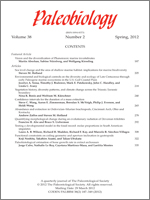Identifying biological traits that promote evolutionary success is fundamental for understanding biodiversity dynamics and for assessing the evolutionary response of organisms to global change. We tested the hypothesis that image-forming eyes have contributed to the diversification of taxa in the geological past. Using fossil occurrences in the Paleobiology Database, we analyzed the diversity and evolutionary rates of more than 17,000 Phanerozoic genera of marine invertebrates living on or above the shallow-water seafloor according to their visual capabilities. Analysis of the complete data set shows a peak in the proportional diversity of sighted genera early in the Phanerozoic, and their continuance at a relatively low and stable level after the Ordovician. As an explanation of this pattern we suggest that selection pressure to develop eyes rose in the Cambrian, and that behavioral constraints had a balancing effect thereafter. In contrast to the pooled data, a clade-level study of those subgroups that contain both sighted and blind genera revealed that—in trilobites, all epifaunal bivalves, pectinoid bivalves, gastropods, and echinoderms—sighted genera diversified more strongly than blind genera. This difference is controlled by significantly raised extinction rates of blind genera. These more finely resolved patterns support the hypothesis that good vision is a key trait that promoted preferential diversification.
How to translate text using browser tools
1 March 2012
Vision and the diversification of Phanerozoic marine invertebrates
Martin Aberhan,
Sabine Nürnberg,
Wolfgang Kiessling
ACCESS THE FULL ARTICLE

Paleobiology
Vol. 38 • No. 2
Spring 2012
Vol. 38 • No. 2
Spring 2012




